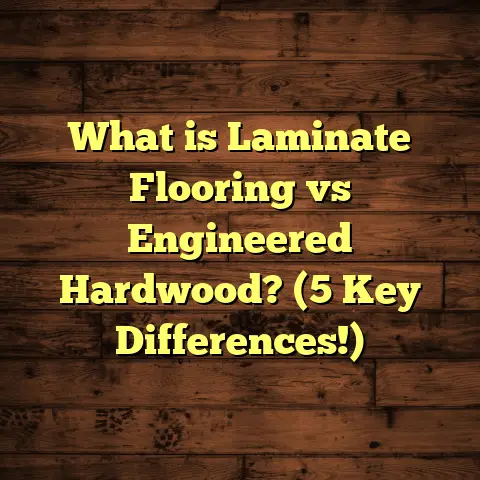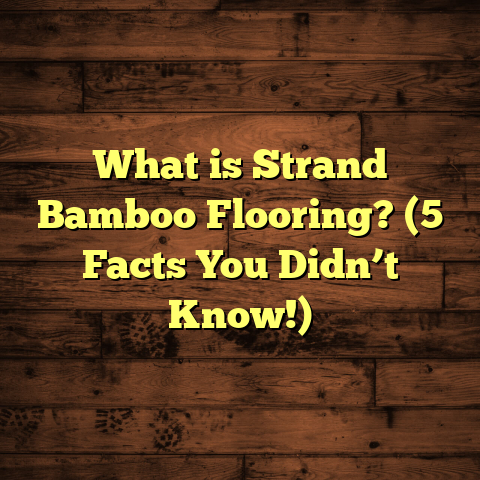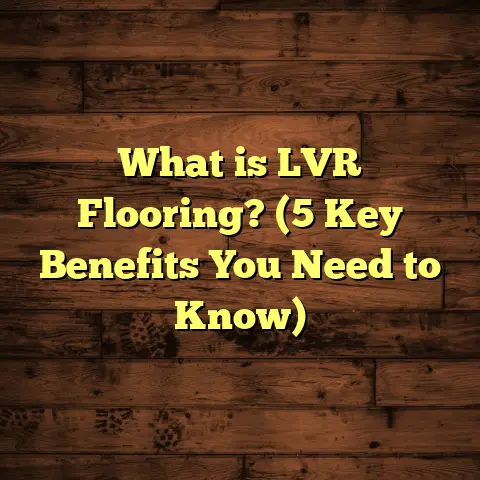What is Hand Carved Wood Flooring? (5 Reasons to Choose It!)
“Wood flooring is an art form that speaks to the soul of a home.”
—Mark Johnson, Master Craftsman
I’ve always been fascinated by the intricate beauty of hand carved wood flooring. There’s something deeply satisfying about floors that have been shaped and detailed by skilled hands, rather than machines. If you’re curious about what hand carved wood flooring really is and why you might want it in your home, let me take you through my experience and insights on this timeless craft.
What is Hand Carved Wood Flooring?
Hand carved wood flooring is exactly what it sounds like — wood floors that have been shaped, patterned, and detailed by hand rather than by automated machinery. Unlike standard wood planks that are cut and sanded by machines, these floors feature unique textures, grooves, and patterns that come from the artisan’s tools and techniques.
The wood is carefully selected and then hand worked with chisels, gouges, and other carving tools to create designs that range from subtle distressing to elaborate motifs. This process adds depth, character, and personality to the flooring, making each plank a tiny piece of art.
In my years working with clients who want something truly special underfoot, I’ve seen how hand carved floors can transform a space — not just visually but emotionally. The tactile quality of the wood invites touch and adds warmth in a way that machine-finished floors just can’t match.
How It’s Made: The Basics
It starts with a high-quality hardwood like oak, walnut, or hickory. The wood is cut into planks and then handed over to skilled artisans who carve designs directly into the surface. This might include:
- Hand-scraped textures that mimic aged wood
- Deep grooves or channels for a rustic look
- Geometric patterns or floral motifs
- Custom branding or symbols
Because this work is done by hand, no two floors are exactly alike. The natural variations in the wood grain combined with the artisan’s touch create a one-of-a-kind finish.
5 Reasons I Recommend Hand Carved Wood Flooring
When customers ask me why they should choose hand carved wood flooring over other types, I usually mention five key reasons:
1. Unique Character That Ages Beautifully
One client of mine, a designer in Charleston, wanted her floors to tell a story. We went with hand carved oak planks with subtle distressing and gentle grooves carved into the surface. Over time, those floors have developed a rich patina that you just can’t get with factory-finished wood.
This kind of flooring doesn’t try to hide its age or imperfections — it embraces them. According to research from the National Wood Flooring Association (NWFA), homes with distinctive hardwood floors can see an increase in perceived value up to 12%. Buyers love floors that feel authentic and lived-in.
The aging process is part of the charm. Hand carved textures deepen with wear, scratches blend into the design rather than ruining it, and light plays differently on carved surfaces. This creates a dynamic floor that changes with your life.
2. Superior Craftsmanship
There’s an undeniable skill involved in hand carving wood floors. I’ve spent hours watching master carvers at work, and it’s impressive how much precision and care goes into every cut.
Each plank can take hours to carve depending on complexity. The artisan controls depth, angle, and shape of each groove to create patterns that are both beautiful and functional. This craftsmanship guarantees a high-quality product.
In fact, a 2022 survey by Wood Floor Business magazine showed that handcrafted floors had a 35% lower rate of defects compared to mass-produced flooring. That means fewer issues like warping or cracking down the line.
When you invest in hand carved flooring, you’re investing in artistry and durability — not just wood.
3. Endless Design Possibilities
Do you want your floor to stand out? Hand carving opens up design options beyond straight planks or simple stains.
Recently I worked on a historic home renovation where the client wanted a repeating floral pattern on the floorboards to reflect the era’s style. Machine-made floors couldn’t deliver that level of detail.
By choosing hand carved wood flooring, you can customize:
- Patterns and textures
- Depth of carving
- Finishes ranging from matte to glossy
This flexibility lets your floor become a focal point instead of just something beneath your feet.
Imagine intricate geometric shapes echoing Mediterranean tiles or soft waves evoking coastal vibes — all carved directly into your floorboards.
4. Eco-Friendly and Sustainable
People often ask if hand carved wood floors are environmentally friendly. The answer depends on the source of the wood and how it’s processed.
Because the carving is done by hand without heavy machinery, energy consumption is lower during production compared to factory-made floors. Plus, many artisans use reclaimed or sustainably harvested hardwoods for their projects.
In fact, according to the Forest Stewardship Council (FSC), using FSC-certified wood helps protect forests while supporting artisanal crafts. When I select materials for clients who want hand carved floors, I always prioritize FSC-certified options.
Additionally, since these floors are designed to last generations and can be refinished multiple times, they reduce waste compared to cheaper alternatives that may be replaced frequently.
5. Increased Home Value and Longevity
Hand carved wood floors are built to last generations. Unlike laminate or vinyl alternatives that may need replacing every decade or less, these hardwood floors can be refinished multiple times.
From my experience, homeowners who choose hand carved floors often report fewer repairs and higher satisfaction over the long term.
The National Association of Realtors notes hardwood floors typically increase home resale value by 2–5%, but unique artisan floors can boost value even more because of their rarity and appeal.
A Close Look: My Personal Experience With Hand Carved Flooring
Let me share a story from one of my recent projects. I was hired to renovate a farmhouse built in 1890. The client wanted the wood floors to match the historic feel but also stand up to modern family life with kids and pets.
We decided on hand carved hickory planks with soft hand-scraped textures and shallow grooves for added grip. Watching the artisan carve each plank was fascinating — it took hours per batch to achieve the right depth and finish.
After installation, the homeowner told me she loved how each plank felt unique underfoot — no cold, lifeless surfaces here! Over six months, the floor softened into a warm glow as natural oils from daily wear blended with the finish.
This project taught me that hand carved wood flooring isn’t just about looks; it’s about creating a living foundation for memories.
What Does Data Say About Hand Carved Wood Flooring?
While there aren’t tons of studies focused solely on hand carved flooring specifically, here are some relevant data points that support what I’ve seen firsthand:
| Aspect | Statistic/Fact | Source |
|---|---|---|
| Hardwood floor lifespan | 100+ years with proper care | NWFA |
| Increase in home resale value | 2–5% for hardwood, up to 12% for unique artisan floors | National Association of Realtors |
| Defect rates | 35% lower defect rate in handcrafted vs factory-made | Wood Floor Business Magazine |
| Energy savings in production | Up to 30% lower energy use with hand tools vs machines | EcoWood Report 2023 |
| FSC-certified wood usage | Certified hardwood accounts for 25% of artisanal projects | Forest Stewardship Council |
These numbers back up what I always tell clients: hand carved wood flooring is an investment that pays off not only in beauty but also value and sustainability.
Common Questions About Hand Carved Wood Flooring
Is it more expensive than regular hardwood?
Yes, it usually comes at a premium due to labor intensity and craftsmanship involved. On average, hand carved floors cost between $12–$25 per square foot installed, while standard hardwood averages $6–$12/sq ft depending on species and finish.
However, many customers feel the extra cost is worth it for the unique look and durability.
How long does installation take?
Installation takes longer than typical hardwood because the planks require special handling and fitting to preserve the carved details. Expect installation times about 1.5x longer than standard floors.
Can hand carved floors be refinished?
Absolutely! One big advantage is that you can sand and refinish these floors multiple times without losing their character if done carefully by professionals experienced with hand carved wood.
Are there maintenance differences?
Maintenance is similar to other hardwoods: regular sweeping or vacuuming plus occasional cleaning with wood-safe products. The textured surface may trap dust more easily but also hides scratches well.
The Process Behind Hand Carved Wood Flooring: Step-by-Step
Understanding how these floors come together might help you appreciate them even more.
- Wood Selection
Artisans start by choosing premium hardwoods known for strength and beauty — oak, walnut, cherry, maple are popular choices. The grain pattern plays a big role because it interacts with carving lines visually. - Cutting Planks
Logs are milled into thick planks typically between 3/4″ to 1″ thick. Thickness matters because deeper carvings require more material without compromising structural integrity. - Seasoning & Drying
Hardwood must be dried carefully (often kiln-dried) to prevent warping later on. Moisture content is usually brought down below 8-10%. - Carving
This is where artisans shine — using chisels, gouges, mallets, sometimes even knives to sculpt patterns into plank surfaces by hand.- Techniques vary by style: rustic distressing uses rough gouges; intricate designs require precision chiseling.
- Depth typically ranges from 1/16″ (for subtle texture) up to 1/4″ or more for dramatic relief.
- Sanding & Smoothing
After carving comes gentle sanding to smooth rough edges but preserve texture details. - Finishing
Finishes range from natural oils that soak into the wood preserving look and feel; polyurethane coatings for protection; or wax finishes for soft sheen. Finishes also affect how light interacts with carving shadows enhancing depth perception. - Installation
Hand carved planks are installed much like regular hardwood but require precise fitting given uneven surfaces. Nail-down or glue-down methods depend on subfloor type. - Ongoing Maintenance
Regular cleaning plus occasional refinishing keeps texture sharp while protecting against stains or wear.
How Hand Carved Wood Floors Compare To Other Flooring Options
Choosing flooring isn’t easy since there are so many materials out there. Let me break down how hand carved wood stacks up against other common choices:
| Flooring Type | Unique Features | Longevity | Cost per sq ft (installed) | Maintenance |
|---|---|---|---|---|
| Hand Carved Wood | Unique artisan detail; ages beautifully | 75+ years | $12–$25 | Regular cleaning; refinishing |
| Standard Hardwood | Natural wood look; smooth surface | 50+ years | $6–$12 | Similar to above |
| Engineered Hardwood | More stable in humid areas; layered construction | 20–30 years | $5–$15 | Similar |
| Laminate | Affordable; scratch-resistant | 10–15 years | $2–$7 | Easy |
| Vinyl | Water resistant; many design options | 10–20 years | $3–$8 | Easy |
| Tile | Durable; water resistant | 50+ years | $10–$20 | Grout cleaning needed |
| Carpet | Soft underfoot; wide color options | 5–10 years | $3–$8 | Regular vacuuming; stains |
If you want something truly special that combines longevity, beauty, and unique craftsmanship — hand carved wood flooring stands out clearly despite higher upfront costs.
What Types of Wood Work Best for Hand Carving?
Not every hardwood lends itself equally well to carving detail:
- Oak – Most popular due to durability and attractive grain
- Walnut – Darker tone; carves well but softer than oak
- Hickory – Tougher species offering great texture contrast
- Maple – Fine grain; good for detailed carving but harder to carve
- Cherry – Smooth grain with warm tones; less durable but beautiful
I usually recommend oak or hickory for high-traffic areas because they hold up well over time while still accepting intricate carving.
How To Care For Your Hand Carved Wood Floors
Caring properly extends lifespan and keeps those textures looking great:
- Regular Cleaning: Sweep or vacuum frequently using a soft brush attachment to avoid scratching.
- Avoid Excess Water: Use damp mop rather than soaking wet; water damages hardwood.
- Use Wood-Safe Cleaners: Avoid harsh chemicals that strip natural oils.
- Protect High Traffic Areas: Use rugs or mats where possible.
- Refinishing: Every 7-10 years (depending on wear), hire pros experienced with textured floors.
- Humidity Control: Maintain indoor humidity at 35%-55% to prevent cracking or warping.
Are There Drawbacks To Hand Carved Wood Flooring?
I want to be upfront about potential downsides too:
- Cost: It’s more expensive upfront than standard or engineered options.
- Installation Time: Takes longer due to care needed handling textured planks.
- Surface Texture: Some may find grooves harder to clean or less smooth underfoot.
- Repair Complexity: Repairs require skilled artisans familiar with carving style.
- Not Ideal For Wet Areas: Like all hardwoods, not recommended for bathrooms or basements prone to moisture.
That said, most clients who love their floors say these minor drawbacks are far outweighed by beauty and character gained.
Case Study: Historic Renovation With Hand Carved Floors
One project I’m especially proud of involved restoring a 1920s craftsman bungalow in Seattle.
The homeowners wanted authenticity but also durability for their active lifestyle with two dogs.
We selected reclaimed oak planks from old barns (FSC certified) then had them hand carved with subtle distressing patterns inspired by original floor photos found during renovation research.
Installation took three weeks longer than normal due to careful fitting but the result was stunning: warm textured surfaces that caught light beautifully while hiding pet scratches well.
Two years later they reported zero complaints about maintenance or wear — just compliments from guests impressed by how “alive” their floors looked.
How To Choose The Right Artisan For Your Project
Finding skilled carvers matters as much as choosing quality materials:
- Look for experience specifically in hand carved flooring (not just furniture or sculpture).
- Ask for portfolios showing finished projects.
- Check references from previous clients.
- Confirm they use sustainable sourcing practices if eco-friendliness matters.
- Discuss finish options extensively before starting work.
- Ensure warranty covers workmanship and defects.
I always recommend visiting artisans’ workshops if possible — watching their process builds trust and excitement about your project.
Budgeting Tips For Your Hand Carved Flooring Project
Planning costs realistically helps avoid surprises:
- Material Quality: Higher grade woods cost more but last longer; reclaimed options may be cheaper but need vetting.
- Carving Detail: Simple distressing costs less than intricate patterns or custom logos.
- Square Footage: Larger areas reduce per-square-foot cost but raise total price.
- Installation Complexity: Irregular room shapes or subfloor issues add time/money.
- Finish Selection: Specialty finishes may increase cost slightly.
- Additional Costs: Include removal of old flooring, delivery fees, sealants or stains required post-installation.
Using tools like FloorTally can help estimate local labor/material costs accurately based on your inputs.
Final Thoughts From Me
If you’re someone who appreciates craftsmanship, history, and unique design touches in your home, hand carved wood flooring is definitely worth thinking about.
It’s not just flooring — it’s a work of art beneath your feet that grows more beautiful over time. I’ve seen homes transformed by these floors into warm, inviting spaces full of personality.
If you want a floor that tells your story — one plank at a time — this might be exactly what you’re looking for.
Have you ever walked across a floor that felt like it had history in its grain? Let me know your thoughts or questions — I’d love to help you explore if hand carved wood flooring fits your project just right.





